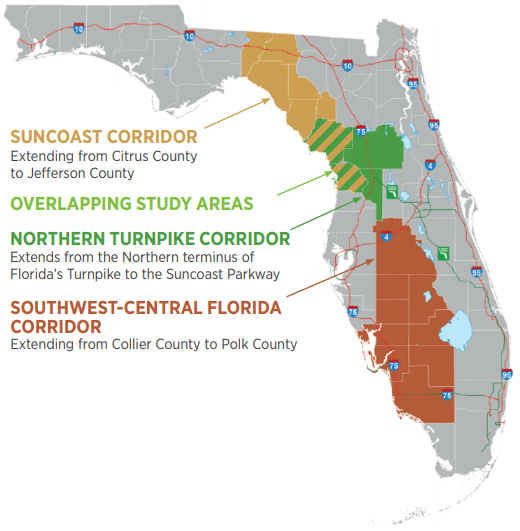TAXWATCH REPORT: The Suncoast Connector is a Multi-Billion Dollar Gamble
TALLAHASSEE, Fla. – Today, Florida TaxWatch (FTW) released its latest report, The Suncoast Connector is a Multi-Billion Dollar Gamble examining the recently created Multi-Use Corridors of Regional Economic Significance (M-CORES) program which was established through legislation passed and signed into law in 2019 (SB 7068) to direct the construction of three new toll roads in the Florida Turnpike System. The report, which focuses primarily on the Suncoast Connector, raises serious concerns regarding economic feasibility, transportation need, environmental and agricultural impact, and economic benefit of this road and urges caution, especially given the revenue impact of COVID-19, before proceeding with the Suncoast Connector whose costs and true value remain in question.
Florida TaxWatch President and CEO Dominic M. Calabro said, “As Florida’s trusted government watchdog, Florida TaxWatch fights tirelessly on behalf of our state’s taxpayers to ensure every hard-earned tax dollar is spent wisely and provides a good return on investment for families across the Sunshine State. While Florida TaxWatch has historically been and continues to be a strong advocate for substantial investments in Florida’s transportation and infrastructure, our analysis of the Suncoast Connector revealed a concerning lack of planning, analysis, or process used in the development and approval of this massive expansion of Florida’s Turnpike System.
“While many of the goals of the M-CORES program, like improving broadband access and providing enhanced infrastructure to Florida’s rural communities are laudable, securing them through the construction of the Suncoast Connector, a costly and potentially unnecessary toll road, is not wise or likely to succeed. The Florida TaxWatch report finds that this project is an unnecessary gamble that could cost Florida and its taxpayers dearly. We urge strong caution and further analysis before proceeding with the Suncoast Connector, especially now that our state is facing significant revenue shortfalls due to COVID-19.”
The three corridors specified in law (Suncoast Connector, Northern Turnpike Connector, and Southwest-Central Florida Connector) would add 330 miles of new road to Florida’s current 498-mile Turnpike system.

Source: FDOT, taken from "Introducing M-CORES," downloaded from https://floridamcores.com/
KEY FACTS AND FINDINGS
- The M-CORES legislation provides increased funding that will reach $100 million annually beginning in FY 2021-22 and directs $35 million in existing Turnpike revenue annually to the program for corridor access and connectivity beginning in FY 2022-23. This will not be all the funds devoted to the project. The law requires the roads be toll roads, so bonds and other authorized funding sources will also be used.
- Although no formal cost estimates have been developed for the roads since routes have yet to be established, Florida TaxWatch’s analysis finds that construction of the Suncoast Connector could range in cost from a low of $4 billion to a high of $10.5 billion – or between $25 million and $70 million per mile.
- Assuming the cost falls at the midpoint of Florida TaxWatch’s estimated range and only 70 percent of total costs are bonded, the Suncoast Connector would be required to produce $2.37 million in toll revenue per mile to satisfy projected bond costs. This is 10 percent more than the average revenue per mile of the entire Florida Turnpike System. At the highpoint estimate, it would require 60 percent more in revenue per mile than the Turnpike average. The only segment close in size to the Suncoast Connector—the 155-mile Ticket System going from Palm Beach County to Osceola County—brings in $1.19 million per mile, half as much as the Suncoast Connector would need at the mid-point estimate.
- Due to its low population, there is relatively little traffic on the current roads in the corridor, including the main road – U.S. 19. In fact, the Turnpike system has a Daily Vehicle Miles Traveled per lane mile that is more than eight times that of U.S. 19. In addition, the current Suncoast Parkway’s per-mile collections of $0.641 million is by far the lowest of any segment of the Turnpike (with the exception of the Beachline East Expressway which has by far the lowest toll charges on the system). It is questionable that ridership on the Suncoast Connector would be sufficient to pay off the bonds.
- There are significant concerns about the Suncoast Connector’s impact on Florida’s environment and agricultural industry:
- Agricultural, recreational, and parklands comprise 88.1 percent of the entire Suncoast Corridor and the area includes natural treasures like the Big Bend Seagrass Aquatic Preserve, springs, aquifer recharge areas, and Florida Forever lands.
- More than 40 percent of Taylor County and 43 percent of Lafayette County are wetlands that could be negatively impacted by runoff.
- There are at least 20 endangered or threatened wildlife species that live in the corridor.
- Farmland makes up 69.3 percent of the total land area in the corridor, presenting potential logistical challenges to farmers transporting supplies, livestock, and equipment across a major roadway.
You can read the full report HERE.